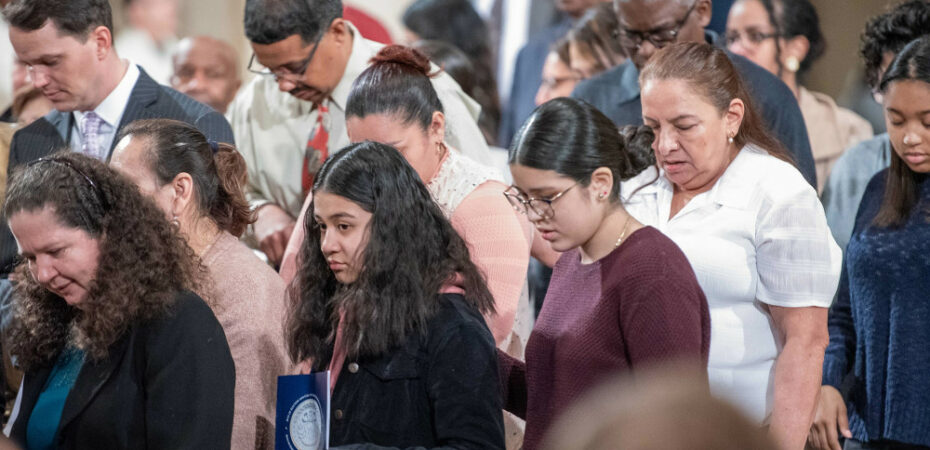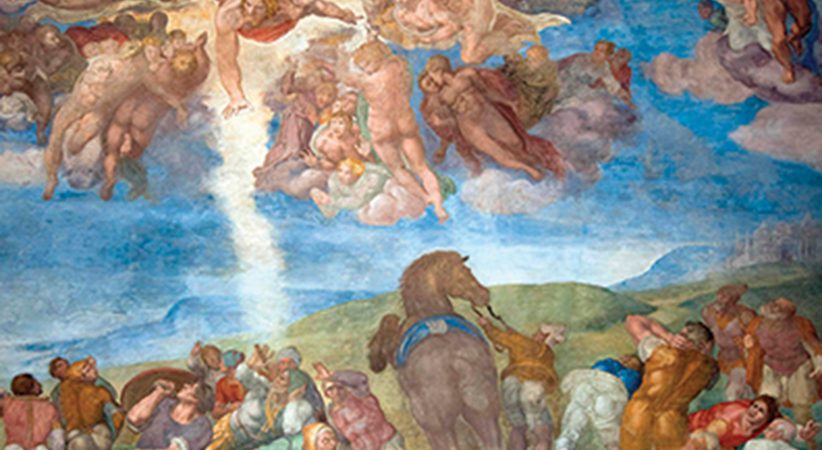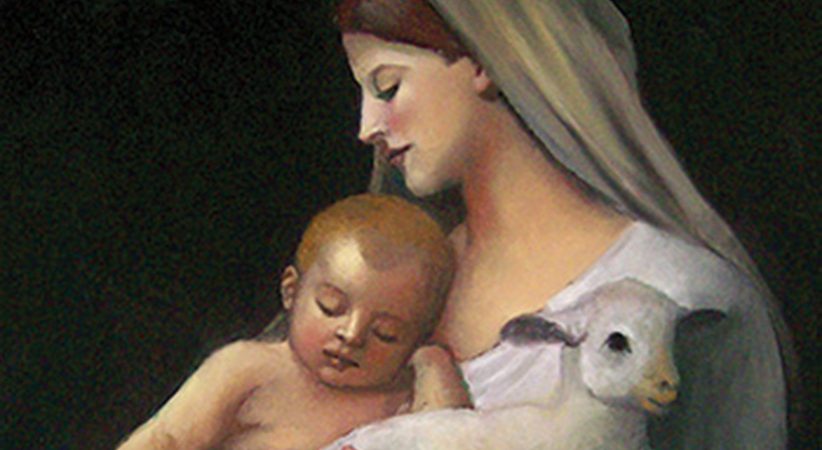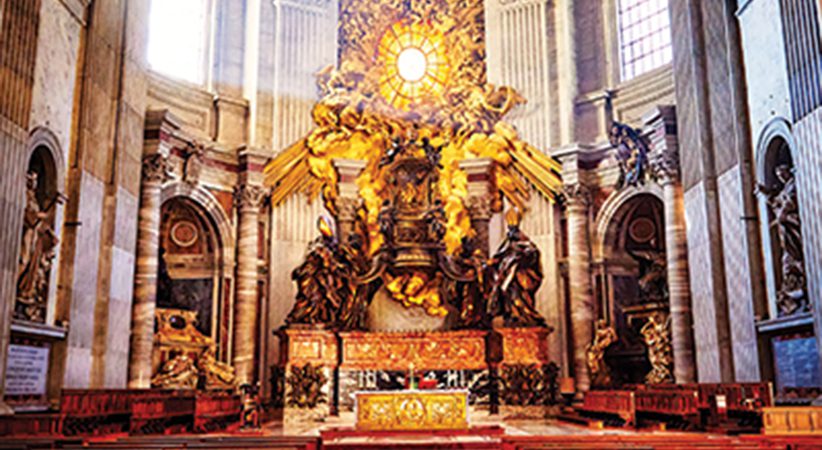From RCIA to OCIA
Preparing for a new translation and a look at the duties of priests
Father Paul Turner Comments Off on From RCIA to OCIA
As we await the revised English translation for the Christian Initiation of Adults, this is a good time to review the expectations that the ritual makes of priests.
The Latin typical edition of this book appeared in 1972, over 50 years ago. It remains unchanged. Other liturgical books have had updates, most famously the Roman Missal in its third edition, but also the orders of baptizing children, matrimony and ordination. The revised English translation of those books also included new material, not in the original typical edition. But the initiation of adults has remained the same, as did, for example, the Order of Confirmation, which also has a revised English translation. What we are expecting, then, is an updated translation, not new things to learn.
Some terms are bound to change, including the very title of the book. Popularly known as “RCIA,” the title is expected to change from the “Rite” to the “Order” of Christian Initiation of Adults. Its acronym will logically change to “OCIA.”
Many people use RCIA to refer to sessions that prepare people for joining the Catholic Church, but the book is an order of service, not a catechetical textbook. It treats the ceremonies connected with initiation in the same way that the Order of Celebrating Matrimony treats the ceremonies for weddings. Engaged couples enjoy catechesis before they are married, but the syllabus comes from other sources. Similarly, the ritual book for initiation envisions that catechesis will happen, but it lets other sources determine how it will happen.
Catechesis
To that end, the Christian initiation of adults presumes that priests will assist in catechesis. Prior to the Second Vatican Council, priests commonly provided all the catechesis for adults joining the Church. Today’s ritual book presumes that the entire community will get involved. However, it does not remove catechesis from the priest’s list of duties.
From the beginning, the order frames the work of priests within their duty to offer pastoral care to catechumens, especially those who may seem hesitant or troubled in any way. With the help of deacons and catechists, a priest catechizes those who seek to know Christ (cf. No. 13). In this early stage, the focus of formation is a suitable explanation of the Gospel (No. 38). Topics do not yet concern the uniqueness of Catholics, but the evangelization of those who may not yet know and love Christ.
Before entering the catechumenate, an inquirer pursues various activities, including making contact with a priest (No. 42). Therefore, the priest should have some knowledge of inquirers from the beginning of their journey. In the case of children of catechetical age, the start of their formation gives the family an opportunity to speak with a priest (No. 254.2). If the inquirer already has a valid Christian baptism, the priest is among those who determine how much formation that person needs in order to receive the sacraments of the Church (No. 402). In all these circumstances, the priest is active from the beginning of catechesis.
During the period of the catechumenate, priests are among those who provide appropriate catechesis (No. 75.1). In fact, the length of time for this period is partly determined by the number of priests available (No. 76). As Lent approaches, parish leaders make a judgment concerning those catechumens who are ready for the Rite of Election, and priests are expected to join this discussion (No. 122). Through his contact with seekers in the early stages of inquiry and the later stages of the catechumenate a priest contributes to the conversation.
Throughout this time, sponsors also assist those in formation. That person may continue as the godparent at baptism, or a different person may serve. Especially when the catechumen may not know many Catholics, the priest himself may choose the godparent he approves both for adults and for children (Nos. 11, 123, 307). In the case of those who already have a valid baptism, the priest approves the sponsor (No. 404).
Liturgies Before the Sacraments of Initiation
The priest presides over a series of rituals that accompany the long path toward initiation. However, a deacon may lead many of these.
The OCIA does not provide a ceremony that admits a person into the period of inquiry or precatechumenate. It permits a conference of bishops to create such a rite, but it envisions an informal event. If there is a gathering of members of the community when inquirers need an introduction, the priest is among those who may welcome them (No. 39.3).
More commonly, when the inquirer is ready to become a catechumen, the priest (or a deacon) presides for the ceremony of entrance (No. 45). An adaptation is offered to unbaptized children of catechetical age (No. 260). Entrance into the catechumenate importantly gives a person certain canonical rights and responsibilities within the Catholic Church. A further optional adaptation applies to validly baptized Christians who are beginning their formation for the Catholic sacraments (No. 416). The ritual provides a combined rite for them and the unbaptized (No. 507).
One of this ceremony’s distinguishing features is the signing of the forehead and other parts of the body (Nos. 55-56). Those who already have a valid baptism may similarly be signed (Nos. 423, 516, 519), but limiting those signs is a practical way to affirm the difference between unbaptized catechumens and baptized candidates.
Other prayerful gatherings may take place during the period of the catechumenate, and priests are listed among those who are to be present (No. 80). For example, he (or a deacon) administers minor exorcisms (No. 91) or blessings (No. 96). Either may also anoint with the oil of catechumens during this time (No. 98), and a priest may bless his own oil for the celebration if he has none that the bishop blessed at the chrism Mass (No. 101). One such anointing would fittingly take place at the conclusion of the Liturgy of the Word at some Sunday Mass during the period of the catechumenate.
Before the Rite of Election, priests may preside over the sending of catechumens to the ceremony that commonly takes place at the cathedral with the bishop presiding (No. 439). If validly baptized candidates for the Catholic sacraments will also be participating in the Call to Continuing Conversion at the cathedral, the priest may preside over their rite of sending, whether it takes place on its own or in combination with the rite for unbaptized catechumens (Nos. 439, 537, 540).
At the Rite of Election, in the presence of the bishop, a priest is listed among those who may present the catechumens and candidates, both adults and children (Nos. 111, 130, 282, 451, 551, 555). Note that the bishop may delegate a priest to preside for the Rite of Election in his stead (No. 121), but no priest may conduct the ceremony in his parish without such permission from the bishop.
During the period of purification and enlightenment, which extends from the Rite of Election to the initiation rites, priests and deacons preside for preparatory ceremonies, most importantly the three scrutinies for unbaptized adults. These include prayers of exorcism (Nos. 144-145). In the case of children, the ritual supplies only a single scrutiny or penitential rite (No. 295), which may be celebrated at any time within this period. It includes an anointing with the oil of catechumens (No. 301) unless the children have already received it. If these children are receiving formation within a peer group of Catholics preparing for their first confession, a priest may celebrate the scrutiny for one group and the first confessions of the other in the same liturgy.
In the case of validly baptized adults preparing for the other sacraments, they are not to undergo any of the three scrutinies. However, the priest has the option of presiding over a distinct penitential rite for them (No. 464).
On the day of the baptisms, usually Holy Saturday before the Easter Vigil, a priest may preside over the preparation rites (No. 185). This may seem inconvenient to many involved with initiation, but these traditional ceremonies help those who have not yet been baptized make their final preparation.
The Sacraments of Initiation
The priest presides over the sacraments of initiation, usually at the Easter Vigil. There are exceptions, as, for example, when a catechumen with good cause cannot be present for the Vigil due to reasons such as work, school, imprisonment, travel or deployment. When necessary, the bishop may authorize celebrating the initiation rites outside the usual times (No. 34.2).
The priest joins the procession to the baptismal font, prays the conclusion to the litany of the saints, blesses the water, elicits the baptismal promises and baptizes the children and adults (Nos. 218-226).
The priest also confirms all adults and children of catechetical age whom he has baptized (Nos. 232-235). Some priests are still surprised to learn that this applies to children younger than the diocesan age for the confirmation of Catholics baptized as infants (Nos. 14, 305, 323). The Code of Canon Law is quite explicit about this. Canon 883.2 grants a priest the faculty to confirm children of catechetical age whom he baptizes, and canon 885.2 obliges him to do it. The faculty is for the benefit of the child.
If the children in the catechumenate underwent their preparation in sessions together with baptized Catholic peers preparing for their confirmation, the ritual makes another surprising request. If the bishop is not present for the baptism and confirmation of these children, he should grant the priest an additional faculty. The law obliges the priest to confirm the children of catechetical age whom he baptizes, but the bishop is to give him also the faculty to confirm in the same ceremony the peer children baptized Catholic as infants (No. 308).
The aforementioned canons also give the priest the faculty and obligation to confirm those whom they receive into the full communion of the Catholic Church. He is to confirm them immediately, so that they may more worthily receive their first holy Communion (No. 481).
Exceptional Cases

Some exceptional cases merit attention. Beginning at No. 340, the book provides a ceremony for someone who has diminished time to pass through all the stages of the catechumenate and needs a compressed period of formation and celebration. This resembles the former ceremony of adult baptism, which put all the stages into a single event, and it bears some resemblance to the baptism of infants, which also puts elements of the other rituals — exorcism and election, for example — into one complex rite. One example justifying this version is a person’s diagnosis with a serious illness. There may not be time for all the steps to unfold over a period of months. This simpler form may then be used. Even here, the priest confirms the person he baptizes (No. 363).
If death is imminent, a different ritual pertains (No. 370). A catechist or any layperson may conduct this special ceremony. A priest or a deacon, however, is ordinarily to use the previous ritual with its more complete celebration (No. 372). A priest who presides even for this ritual is to confirm (Nos. 388, 391). If the lay presider is also an extraordinary minister of holy Communion, he or she administers viaticum. A priest, of course, would do the same.
The forthcoming revised translation is expected to keep all these points in place. A priest may use this time to review his roles in the RCIA, so as to provide even better service in the OCIA.
FATHER PAUL TURNER is pastor of the Cathedral of the Immaculate Conception in Kansas City, Missouri, and director of the Office of Divine Worship for the Diocese of Kansas City-St. Joseph.
…………………………………………………………………………………………………………………………………………..
Welcoming Lapsed Catholics
The U.S. bishops’ website references Catholics that left the Church but desire to return: “For Catholics who have been Baptized, Confirmed and made First Communion but then drifted from the faith, the way they return is through the Sacrament of Penance. Catholics who were baptized but never received Confirmation and/or Eucharist also participate in a period of formation. This process of formation is completed with the reception of the Sacraments of Confirmation and Holy Communion often at the Easter Vigil or during the Easter Season.”
…………………………………………………………………………………………………………………………………………..





